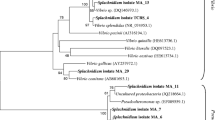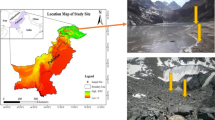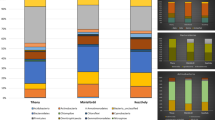Abstract
In recent years, seasonal blooms of the dinoflagellate Noctiluca miliaris have appeared in the open-waters of the northern Arabian Sea (NAS). This study provides the first characterization of bacteria from a seasonal bloom of green Noctiluca of NAS (20°N−17°N and 64°E–70°E), during the spring-inter-monsoon cruise of Sagar Sampada 253, in March 2007. Bacterial growth as assessed by most-probable number (MPN) and plate counts, revealed ‘variable-physiotypes’ over a wide range of salinities (0%–25% w/v NaCl), pH levels (5–8.5), and organic nutrient strengths, in comparison to non-bloom waters. MPN indices of bacteria in surface waters of bloom stations *DWK and *PRB, corresponded to (3.08–4.41)×103 cells/mL at 3.5% NaCl (w/v), and (2.82–9.49)×102 cells/mL at 25% (w/v) NaCl in tryptone-yeast extract broth (TYE). Plate counts were (1.12–4)×106 CFU/mL at 0% (w/v) NaCl, (1.28–3.9)×106 CFU/mL at 3.5% (w/v) NaCl, and (0.4–7)×104 CFU/mL at 25% NaCl (w/v) on TYE. One-tenth-strength Zobell’s gave (0.6–3.74)×105 CFU/mL at pH 5 to (3.58–7.5)×105 CFU/mL at pH 8.5. These bacteria were identified to the genera Bacillus, Cellulomonas, Staphylococcus, Planococcus, Dietzia, Virgibacillus, Micrococcus, Sporosarcinae, Leucobacter, and Halomonas. The identity of three strains (GUFBSS253N2, GUFBSS253N30, and GUFBSS253N84) was confirmed through 16S rDNA sequence homology as Bacillus cohnii, Bacillus flexus, and Bacillus cereus. The ∼2–3-fold higher plate counts of culturable bacteria from the open-waters of the NAS indicate that these bacteria could critically determine the biogeochemical dynamics of the bloom and its milieu. The role of these bacteria in sustaining/terminating the bloom is under evaluation.
Similar content being viewed by others
References
Ausubel F M, Brent R, Kingston R E, Moore D D, Siedman J G, Smith J A, Struhl K. 1995. Short Protocols in Molecular Biology. Wiley. p.2.11–2.12.
Al-Awadhi H, Sulaiman R H D, Mahmoud H M, Radwan S S. 2007. Alkaliphilic and halophilic hydrocarbon utilizing bacteria from the Kuwaiti coasts of the Arabian Gulf. Appl. Microbiol. Biotechnol., 77: 183–186.
Azam F, Steward G F, Smith D C, Ducklow H W. 1994. Significance of bacteria in the carbon fluxes of the Arabian Sea. J. Earth Syst. Sci., 103(2): 341–351.
Basu S, Matondkar S G P, Furtado I. 2011. Enumeration of bacteria from a Trichodesmium spp. bloom of the Eastern Arabian Sea: elucidation of their possible role in biogeochemistry. J. Appl. Phycol., 23(2): 309–319.
Cruickshank R. 1973. Medical Microbiology: A Guide to the Laboratory Diagnosis and Control of Infection, 11th ed. Churchill Livingstone, Edinburgh. 1 070p.
Csonka L N. 1989. Physiological and genetic responses of bacteria to osmotic stress. Microbiol. Rev., 53(1): 121–147.
DeSousa S N, Kumar D M, Sardessai S, Sarma V V S S, Shirodkar P V. 1996. Seasonal variability in oxygen and nutrients in the central and eastern Arabian Sea. Current Sci., 71(11): 857–862.
Diaz M P, Grigson S J W, Peppiat C J, Burgess J G. 2000. Isolation and characterization of Novel Hydrocarbondegrading Euryhaline consortia from crude oil and Mangrove sediments. Mar. Biotechnol., 2: 522–532.
Ducklow H W, Smith D C, Campbell L, Landry M R, Quinby H L, Steward G F, Azam F. 2001. Heterotrophic bacterioplankton in the Arabian Sea: basinwide response to year-round high primary productivity. Deep-Sea Res. Part II, 48(6–7): 1 303–1 323.
Elbrachter M, Qi Y. 1998. Aspects of Noctiluca (Dinophyceae) population dynamics. In: Anderson D M, Cembella A, Hallegraeff G M eds. Physiological Ecology of Harmful Algal Blooms. NATO ASI Series, 41, Berlin. p.315–335.
Empadinhas N, Da-Costa M S. 2008. Osmoadaptation mechanisms in prokaryotes: distribution of compatible solutes. Int. Microbiol., 11: 151–161.
Fernandes C E. 2006. Salt-pan Ecology and Its Impact on Community Structure of Halophilic Archaea. PhD. Thesis. Goa University, India. 261p.
Ferreira J G, Andersen J H, Borja A et al. 2012. Overview of eutrophication indicators to assess environmental status within the European Marine Strategy Framework Directive. Est. Coast. Shelf. Sci., 93(2): 117–131.
Furuya K, Saito H, Sriwoon R, Vijayan A K, Omura T, Furio E E, Borja V M, Boonyapiwat S, Lirdwitayaprasit T. 2006. Persistent whole-bay red tide of Noctiluca scintillans in Manilla Bay, Phillipines. Coast. Mar. Sci., 30(1): 74–79.
Ghoul M, Bernard T, Cormier M. 1990. Evidence that Escherichia coli accumulates glycine betaine from marine sediments. Appl. Environ. Microbiol., 56(2): 551–554.
Giebel H A, Kalhoefer D, Lemke A, Thole S, Janssen R G, Simon M, Brinkhoff T. 2011. Distribution of Roseobacter RCA and SAR11 lineages in the North Sea and characteristics of an abundant RCA isolate. ISME. J., 5: 8–19.
Gomes H do R, Goes J I, Matondkar S G P, Parab S G, Al-Azri A R N, Thoppil P G. 2008. Blooms of Noctiluca miliaris in the Arabian Sea-An in situ and satellite study. Deep-Sea Res. Part I, 55: 751–765.
Green D H, Llewellyn L E, Negri A P, Blackburn S I, Bolch C J S. 2004. Phylogenetic and functional diversity of the cultivable bacterial community associated with the paralytic shellfish poisoning dinoflagellate Gymnodinium catenatum. FEMS. Microbial. Ecol., 47(3): 345–357.
Harrison P J, Furuya K, Gilbert P M et al. 2011. Geographical distribution of red and green Noctiluca scintillans. Chin. J. Oceanol. Limnol., 29(4): 807–831.
Holt J G, Krieg N R, Sneath P H A, Staley J T, Williams S T. 1994. Bergey’s Manual of Determinative Bacteriology, 9th ed. Williams and Wilkins, Baltimore.787p.
Kaye J Z. 2003. Ecology, Phylogeny and Physiological Adaptations of Euryhaline and Moderately Halophilic Bacteria from Deep-sea and Hydrothermal-vent Environments. PhD Thesis. University of Washington, USA. 250p.
Kaye J Z, M’arquez M C, Ventosa A, Baross J A. 2004. Halomonas neptunia sp. nov., Halomonas sulfidaeris sp. nov., Halomonas axialensis sp. nov., and Halomonas hydrothermalis sp. nov.: halophilic bacteria isolated from deep-sea hydrothermal-vent environments. Int. J. Syst. Evol. Micr., 54: 499–511.
Kaye J Z, Baross J A. 2000. High incidence of halotolerant bacteria in Pacific hydrothermal vent and pelagic environments. FEMS. Microbiol. Ecol., 32(3): 249–260.
Kaye J Z, Sylvan J B, Edwards K J, Baross J A. 2011. Halomonas and Marinobacter ecotypes from hydrothermal vent, subseafloor and deep-sea environments. FEMS. Microbiol. Ecol., 75(1): 123–133.
Kempf B, Bremer E. 1998. Uptake and synthesis of compatible solutes as microbial stress responses to high-osmolality environments. Arch. Microbiol., 170: 319–330.
Kirchner M, Wichels A, Seibold A, Sahling G, Schutt C. 2001. New and potentially toxic isolates from Noctiluca scintillans (Dinoflagellate). In: Hallegraff G ed. Proceedings on Harmful Algae, 9th International Conference on Harmful Algae Blooms, Tasmania 2000. p.379–382.
Knap A, Michaels A, Clos A, Ducklow H W, Dickson A. 1994. Protocols for the Joint Global Ocean Flux Study (JGOFS) Core Measurements, IOC Manuals and Guides No.29, UNESCO. p.128–134.
Kushner D J, Kamekura M. 1988. Physiology of halophilic eubacteria. In: Rodriguez-Valera F ed. Halophilic Bacteria. vol. I. Boca Raton FL, CRC Press. p.109–138.
Madhupratap M, Prasanna Kumar S, Bhattathiri P M A, Dileep Kumar M, Raghukumar S, Nair K K C, Ramaiah N. 1996. Mechanism of the biological response to winter cooling in the northeastern Arabian Sea. Nature, 384: 549–552.
Margesin R, Schiner F. 2001. Potential of halotolerant bacteria and halophilic microorganisms for biotechnology. Extremophiles, 5: 73–81.
Matondkar S G P, Bhat S R, Dwivedi R M, Nayak S R. 2004. Indian Satellite IRS-P4 (OCEANSAT) monitoring algal blooms in the Arabian Sea. Harmful Algae News, 26: 4–5, http://ioc.unesco.org/hab.
Miller M B, Bassler B L. 2001. Quorum sensing in bacteria. Annu. Rev. Microbiol., 55: 165–199.
Mimura H, Nagata S. 2000. Isolation of halotolerant microorganisms from seawater around the Inland Sea in western Japan. Microbes. Environ., 15(4): 217–221.
Nawata T, Sibaoka T. 1976. Ionic composition and pH of the vacuolar sap in marine dinoflagellate Noctiluca. Plant. Cell. Physiol., 17(2): 265–272.
Naqvi S W A, Jayakumar D A, Narvekar P V, Naik H, Sarma V V S S, D’souza W, Joseph S, George M D. 2000. Increased marine production of N2O due to intensifying anoxia on the Indian continental shelf. Nature, 408: 334–346.
Nayak B B, Karunasagar I, Karunasagar I. 2000. Bacteriological and physico-chemical factors associated with Noctiluca miliaris bloom along Mangalore south west coast of India. Indian J. Mar. Sci., 29: 139–143.
Raghavan T M, Furtado I. 2004. Occurrence of extremely halophilic Archaea in sediments from the continental shelf of west coast of India. Current Sci., 86(8): 1 065–1 067.
Reva O N, Sorokulova I B, Smirnov V V. 2001. Simplified technique for identification of the aerobic spore-forming bacteria by phenotype. Int. J. Syst. Evol. Micr., 51: 1 361–1 371.
Sapp M, Schwaderer A S, Wiltshire K H, Hoppe H G, Gerdts G, Wichels A. 2007. Species-specific bacterial communities in the phycosphere of microalgae? Microb. Ecol., 53(4): 683–699.
Schlitzer R. 2012. Ocean Data View, http://odv.awi.de.
Seibold A, Wichels A, Schutt C. 2001. Diversity of endocytic bacteria in the dinoflagellate Noctiluca scintillans. Aquat. Microb. Ecol., 25: 229–235.
Smibert R M, Krieg N R. 1994. Phenotypic characterization. In: Gerhardt P ed. Methods for General and Molecular Bacteriology. American Society for Microbiology, Washington DC. p.607–654.
Strickland J D H, Parsons T R. 1972. A practical handbook of seawater analysis. Bull. Fish. Res. Bd. Can., 167: 71–75.
Szvetnik A, Bihari Z, Szabo Z, Kelemen O, Kiss I. 2010. Genetic manipulation tools for Dietzia spp. J. Appl. Microbiol., 109(5): 1 845–1 852.
Sweeny B. 1976. Pedinomonas noctilucae (Prasinophyceae), the flagellate symbiotic in Noctiluca (Dinophyceae) in South-East Asia. J. Phycol., 12: 460–464.
Troussellier M, Bonnefont J L, Courties C, Derrien A, Dupray E, Gauthier M, Gourmelon M, Joux F, Lebaron P, Martin Y, Pommepuy. 1998. Responses of enteric bacteria to environmental stresses in seawater. Oceanologica Acta, 6: 965–981.
Ventosa A, Nieto J J, Oren A. 1998. Biology of moderately halophilic bacteria. Microbiol. Mol. Biol. Rev., 62(2): 504–544.
Wiggert J D, Hood R R, Banse K, Kindle J C. 2005. Monsoondriven biogeochemical processes in the Arabian Sea. Prog. Oceanogr., 65: 176–213.
Wood J M. 1999. Osmosensing by bacteria: signals and membrane-based sensors. Microbiol. Mol. Biol. Rev., 63(1): 230–263.
Wang Q, Garrity G M, Tiedje J M, Cole J R. 2007. Naïve Bayesian Classifier for rapid assignment of rRNA sequences into the new bacterial taxonomy. Appl. Environ. Microbiol., 73(16): 5 261–5 267.
Author information
Authors and Affiliations
Corresponding author
Rights and permissions
About this article
Cite this article
Basu, S., Matondkar, S.G.P. & Furtado, I. Retreived bacteria from Noctiluca miliaris (green) bloom of the northeastern Arabian Sea. Chin. J. Ocean. Limnol. 31, 10–20 (2013). https://doi.org/10.1007/s00343-013-2017-2
Received:
Accepted:
Published:
Issue Date:
DOI: https://doi.org/10.1007/s00343-013-2017-2




